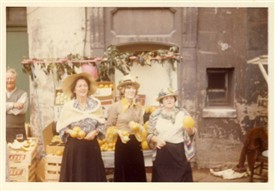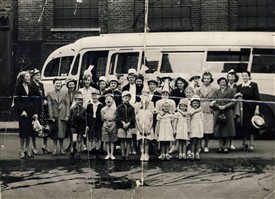Lyn Baker
A Life Lived in Covent Garden
An interview conducted by Patrick Preston

Lyn Baker raising money for Smiths charity run
Lyn Baker

Lyn Baker (middle) during the 1974 Covent Garden Festival
Lyn Baker

Lyn Baker and other Covent Garden residents on a childhood day trip.
Lyn Baker
‘It’s not a bad area to live, is it? You’d love to live here, wouldn’t you?’ Lyn Baker has offered to buy me a Covent Garden flat, when she wins the lottery. She can’t quite believe how much this neighbourhood has come to be worth over the several decades since the market’s closure. ‘As John Toomey, who was one of the people who started the campaign said, “I can’t believe the pavements I used to play hopscotch on are now worth a million.” Young people can’t afford to live here now.’
Lyn, now 74 and living at Drury Lane, has always taken an interest in local housing. She remembers her first Covent Garden Community Association meeting in the early 70s, and feeling spurred to go because of the poor electrics in her aunt’s nearby flat. This led to a long engagement with the Association and the campaign to save Covent Garden from development; attending most of the meetings and many of the protests while working nearby as a secretary.
Although Lyn has witnessed a lot of development in the neighbourhood since the 70s:
the campaign worked well for many. It certainly worked so we got some housing. They wanted to build tower blocks on the Dudley Court site. There’s no high rises here. A lot of people got what they wanted which was a new flat. The block I’m in now…very nice I must admit. They fought the battle for decent housing around here. Some of the old blocks still remain, but they’ve been tarted up as well, like Fletcher, Beaumont and Sheridan at the bottom of Drury Lane.
A lot of these have since been bought, and over the decades, faces have changed and come and gone, but, as Lyn says ‘you’ve got such a diverse community around here now.’
Yet many faces remain familiar, and some of Lyn’s five year old school-friends are her neighbours seventy years later: ‘We’re like sisters really’. Growing up, wandering the neighbourhood unnoticed was an impossibility, but it’s now often an everyday experience on the tourist trails of Covent Garden:
When I was at school at St Clement Danes, say I’d have wanted to hop the ‘wag’, I doubt very much I’d have got to Long Acre without somebody saying ‘Where are you going and does your dad know?’ It was literally a village I suppose. Whereas today, I could walk up and down Drury Lane all day long and probably not see anybody. Have you not heard that expression, hop the ‘wag’?
As it happens, I have, and I remember ‘wagging’, or skipping, school not so long ago. The neighbourhood might look different, but a lot of old habits continue.
The closing of the market in 1974 brought one of the area’s biggest changes, and its annoying effects still linger for Lyn, who has seen the replacement of basic food shops with designer clothes stores and restaurants. When the market closed:
You couldn’t get anything here at all. We opened a shop in the community centre selling eggs and bacon and butter. It was absolutely dead here. Sainsbury’s was a grocers then. They weren’t making enough money, and then they just left. It was like a ghost town, an absolute ghost town. Horrendous. There was no way they were gonna save the market – the streets were too narrow. But it was a lot of fun trying. Well, some of it fun and some not so much.
Lyn isn’t so keen on today’s crowds, noise and the high costs of the piazza. ‘It’s alright for the tourists. But if you want a pint of milk or a loaf of bread, don’t come to Covent Garden. And we were saying that in the 70s. You could’ve bought a kaftan and beads, but you couldn’t have got a loaf of bread and a pint of milk.’ Lyn wants a decent supermarket in Covent Garden, one that doesn’t charge higher prices for being in the centre of town. ‘We’ve got tourist shops but there’s nothing else: a pizza bar, café, tattooists, the fish shop replaced by a restaurant.’
Despite such changes to daily life, many were reluctant to leave their homes under the redevelopment plans of the 70s. ‘They were happy here. If it hadn’t have been for the people who set up the CGCA, I don’t know what it would be like. The number of meetings and rallies. Because no one wanted to move.’ Lyn feels lucky to still live in this neighbourhood, and it remains an often charming place for her, with memories of green spaces and growing strawberries in one of the gardens at the end of Drury Lane. ‘We had gardens everywhere.’ St Paul’s Churchyard remains an oasis next to the piazza amidst the throngs of tourists, and is one of Lyn’s favourite spots in the neighbourhood to escape for some quietude. And this neighbourhood is also a place of community, one where Lyn’s friends live. During our interview, Lyn turns to a friend and shares a joke across the room. ‘I know a lot of people around here really. Perhaps for the older generation there aren’t so many around here that they do know, but it still does have a certain community. The grassroots are still there. I just hope that their children will be able to live here without getting priced out.’
This interview was conducted as part of the Lottery Heritage Fund project, ‘Gentleman We’ve Had Enough: The Story of the Battle to Save Covent Garden ’. On Friday 10 May 2013, King’s College London students, supported by Westminster Archives, the Covent Garden Community Association, and the Centre for Life-Writing Research at King’s College London, interviewed Covent Garden residents about their memories of the area. Students’ accounts of their interviews have been added to this Covent Garden Memories website. For more information see: www.kcl.ac.uk/artshums/ahri/centres/lifewriting/gentlemen.aspx.